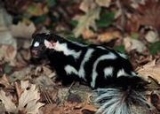
Eastern Spotted Skunk
Encyclopedia
The Eastern Spotted Skunk (Spilogale putorius) is a small, relatively slender skunk
found throughout the eastern United States
and in small areas of Canada
and Mexico
.
This small (16–23 in (40.6–58.4 cm)) skunk is more weasel-like in body shape than the more familiar Striped Skunk
. The Eastern Spotted Skunk has four stripes on its back which are broken in pattern, giving it a "spotted" appearance. They have a white spot on their forehead. They are found in Canada (southeast Manitoba and northwestern Ontario), the United States and northeastern Mexico. Males (463-610mm) are large than females (403-544mm). The males generally weigh between 1-2.5 lbs. and the females 0.8 to 1.25 lbs. Skull length is 43-55mm. Overall, the eastern spotted skunk is very small.
They are much more active than any other type of skunk. They have mostly the same predators as any other skunk (big cats, bobcats, owls, humans, etc.). Up to eight skunks may share an underground den in the winter. They can also climb and take shelter in trees.
Eastern Spotted Skunks seem to prefer forest edges and upland prairie grasslands, especially where rock outcrops and shrub clumps are present. In western counties, it relies heavily on riparian corridors where woody shrubs and woodland edges are present. Woody fencerows, odd areas, and abandoned farm buildings are also important habitat for Eastern Spotted Skunks.
Skunk
Skunks are mammals best known for their ability to secrete a liquid with a strong, foul odor. General appearance varies from species to species, from black-and-white to brown or cream colored. Skunks belong to the family Mephitidae and to the order Carnivora...
found throughout the eastern United States
United States
The United States of America is a federal constitutional republic comprising fifty states and a federal district...
and in small areas of Canada
Canada
Canada is a North American country consisting of ten provinces and three territories. Located in the northern part of the continent, it extends from the Atlantic Ocean in the east to the Pacific Ocean in the west, and northward into the Arctic Ocean...
and Mexico
Mexico
The United Mexican States , commonly known as Mexico , is a federal constitutional republic in North America. It is bordered on the north by the United States; on the south and west by the Pacific Ocean; on the southeast by Guatemala, Belize, and the Caribbean Sea; and on the east by the Gulf of...
.
This small (16–23 in (40.6–58.4 cm)) skunk is more weasel-like in body shape than the more familiar Striped Skunk
Striped Skunk
The striped skunk, Mephitis mephitis, is an omnivorous mammal of the skunk family Mephitidae. Found over most of the North American continent north of Mexico, it is one of the best-known mammals in Canada and the United States.-Description:...
. The Eastern Spotted Skunk has four stripes on its back which are broken in pattern, giving it a "spotted" appearance. They have a white spot on their forehead. They are found in Canada (southeast Manitoba and northwestern Ontario), the United States and northeastern Mexico. Males (463-610mm) are large than females (403-544mm). The males generally weigh between 1-2.5 lbs. and the females 0.8 to 1.25 lbs. Skull length is 43-55mm. Overall, the eastern spotted skunk is very small.
They are much more active than any other type of skunk. They have mostly the same predators as any other skunk (big cats, bobcats, owls, humans, etc.). Up to eight skunks may share an underground den in the winter. They can also climb and take shelter in trees.
Eastern Spotted Skunks seem to prefer forest edges and upland prairie grasslands, especially where rock outcrops and shrub clumps are present. In western counties, it relies heavily on riparian corridors where woody shrubs and woodland edges are present. Woody fencerows, odd areas, and abandoned farm buildings are also important habitat for Eastern Spotted Skunks.
Breeding
Eastern spotted skunks breed mostly in the later winter months and give birth in late Spring to early Summer. On average the female skunk will give birth to 4–5 baby skunks (kits) at a time. It takes twelve weeks before newborn skunks will become fully developed into adult skunks and two months before they develop skunk musk to use as self-defense.External links
- Kinlaw A. E. (1995). "Eastern Spotted Skunk (Spilogale putorius)". Mammalian Species 511
- Smithsonian Institution - North American Mammals: Spilogale putorius
- Eastern Spotted Skunk Spilogale putorius
- IOWA'S ENDANGERED AND THREATENED PLANT AND ANIMAL SPECIES: http://www.iowadnr.gov/other/files/chapter77.pdf
- Eastern Spotted Skunk

